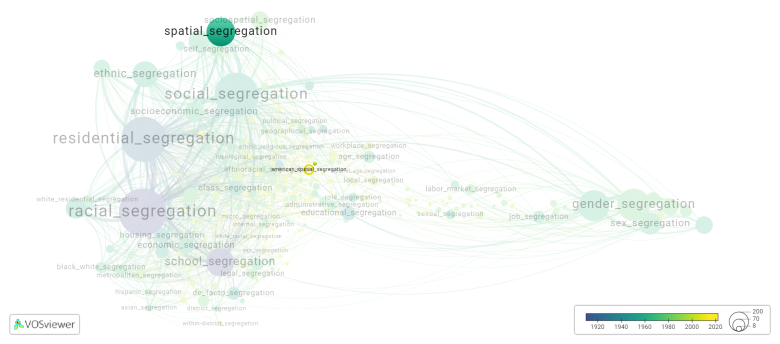American spatial segregation: Difference between revisions
(Creating page) |
(Creating page) |
||
| (10 intermediate revisions by the same user not shown) | |||
| Line 1: | Line 1: | ||
===== Date and country of first publication<ref>Date and country of first publication as informed by the Scopus database (December 2023).</ref>===== | |||
2021<br> | 2021<br> | ||
Israel | Israel | ||
===== Definition ===== | |||
Spatial segregation in America refers to the physical separation of different racial or ethnic groups in urban areas. This segregation has historically been enforced through discriminatory housing policies, such as redlining, restrictive covenants, and exclusionary zoning practices. | Spatial segregation in America refers to the physical separation of different racial or ethnic groups in urban areas. This segregation has historically been enforced through discriminatory housing policies, such as redlining, restrictive covenants, and exclusionary zoning practices. | ||
| Line 12: | Line 12: | ||
Efforts to address spatial segregation include fair housing laws, affordable housing initiatives, and community development programs aimed at promoting diversity and inclusivity in neighborhoods. However, the entrenched nature of segregation in American society makes these challenges difficult to overcome. | Efforts to address spatial segregation include fair housing laws, affordable housing initiatives, and community development programs aimed at promoting diversity and inclusivity in neighborhoods. However, the entrenched nature of segregation in American society makes these challenges difficult to overcome. | ||
==See also== | ==See also== | ||
==Related segregation forms== | |||
American spatial segregation is frequently discussed in the literature with the following segregation forms: | |||
[[spatial segregation]] | |||
[[File:american_spatial_segregation.png|780x780px]] | |||
This visualization is based on the study [[Segregation_Wiki:About| The Multidisciplinary Landscape of Segregation Research]]. | |||
For the complete network of interrelated segregation forms, please refer to: | |||
* [https://tinyurl.com/2235lkhw First year of publication] | |||
* [https://tinyurl.com/2d8wg5n3 Louvain clusters] | |||
* [https://tinyurl.com/223udk5r Betweenness centrality] | |||
* [https://tinyurl.com/244d8unz Disciplines in which segregation forms first emerged (Scopus database).] | |||
==References== | ==References== | ||
==Notes== | ==Notes== | ||
<references /> | <references /> | ||
{{NoteAI}} | {{NoteAI}} | ||
== | ==American spatial segregation appears in the following literature== | ||
Stern S. (2021) | Stern S. (2021). "Separate, therefore equal": American spatial segregation from Jim Crow to Kiryas Joel. ''RSF'', ''7''(1), 67-90. Russell Sage Foundation.https://doi.org/10.7758/RSF.2021.7.1.05 | ||
Latest revision as of 07:17, 16 October 2024
Date and country of first publication[1][edit | edit source]
2021
Israel
Definition[edit | edit source]
Spatial segregation in America refers to the physical separation of different racial or ethnic groups in urban areas. This segregation has historically been enforced through discriminatory housing policies, such as redlining, restrictive covenants, and exclusionary zoning practices.
These policies have contributed to the creation of predominantly white neighborhoods and predominantly minority neighborhoods, often resulting in stark disparities in economic opportunity, educational attainment, and overall quality of life.
While overtly discriminatory practices are now illegal, the legacy of spatial segregation continues to impact communities across the United States. Many neighborhoods remain racially segregated, perpetuating inequalities and limiting social mobility for minority populations.
Efforts to address spatial segregation include fair housing laws, affordable housing initiatives, and community development programs aimed at promoting diversity and inclusivity in neighborhoods. However, the entrenched nature of segregation in American society makes these challenges difficult to overcome.
See also[edit | edit source]
Related segregation forms[edit | edit source]
American spatial segregation is frequently discussed in the literature with the following segregation forms:
This visualization is based on the study The Multidisciplinary Landscape of Segregation Research.
For the complete network of interrelated segregation forms, please refer to:
References[edit | edit source]
Notes[edit | edit source]
- ↑ Date and country of first publication as informed by the Scopus database (December 2023).
At its current state, this definition has been generated by a Large Language Model (LLM) so far without review by an independent researcher or a member of the curating team of segregation experts that keep the Segregation Wiki online. While we strive for accuracy, we cannot guarantee its reliability, completeness and timeliness. Please use this content with caution and verify information as needed. Also, feel free to improve on the definition as you see fit, including the use of references and other informational resources. We value your input in enhancing the quality and accuracy of the definitions of segregation forms collectively offered in the Segregation Wiki ©.
American spatial segregation appears in the following literature[edit | edit source]
Stern S. (2021). "Separate, therefore equal": American spatial segregation from Jim Crow to Kiryas Joel. RSF, 7(1), 67-90. Russell Sage Foundation.https://doi.org/10.7758/RSF.2021.7.1.05

